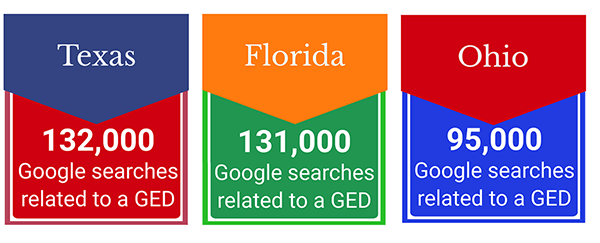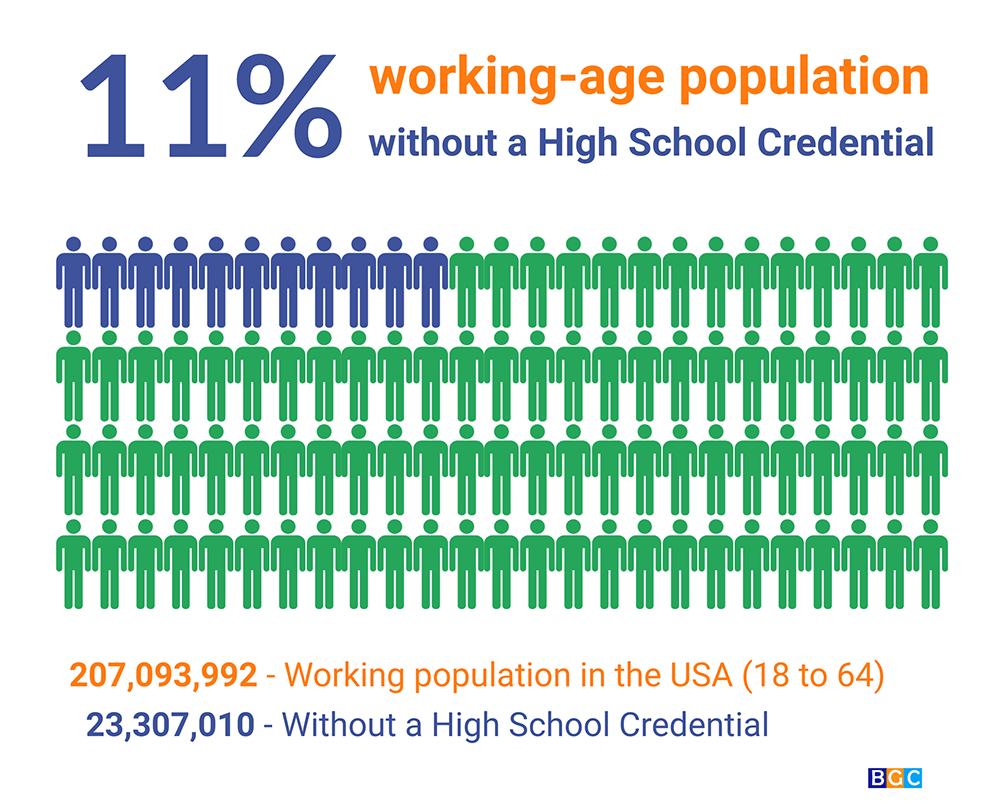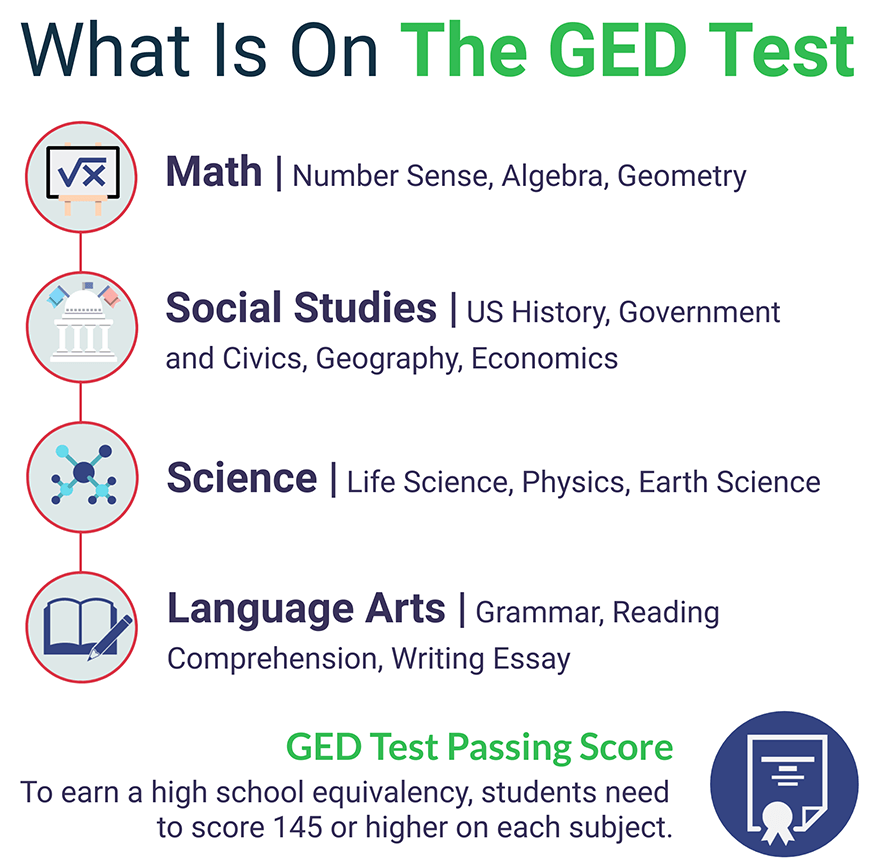The GED exam offers people who, for whatever reason, could not finish high school the opportunity to earn an equivalent credential. Here, we show you some interesting GED statistics.
This website provides online free GED classes and practice tests to help you get started on your GED prep journey.
Online GED Classes – Fast and Easy
Prepare Quickly To Pass The GED Test.
Get Your Diploma in 2 Months.
They allow you to check if working with an online course suits you well, and if it does, we recommend you register with Onsego Online GED Prep, a full-scope, accredited program that will get you optimally prepared fast.
Now, let’s take a look at some GED statistics – How popular is the GED test in 50 states.
Florida, Texas, and Ohio emerged as states where the GED (General Education Development) exam is the most popular among the 50 states, according to research conducted for Best GED Classes.
Pass Your GED in 2 months
This prep is simple and easy
Video lessons | Practice tests | GED Skill Builders
All images and charts are free to use and publish, but we would appreciate it if you could credit Best GED Classes for them. If you are interested in high-resolution images, get in touch with us.

The GED Diploma is recognized and accepted by government agencies, employers, colleges, and universities in lieu of a traditional high school diploma. Students who pass the 4 GED subject tests receive their High School Equivalency diplomas. The common way of preparing for the GED tests is by taking online or traditional classes.
As said earlier, Best GED Classes offers free online GED classes and GED practice tests and publishes lists of traditional classes across the country as well. Our free online lessons are courtesy of Onsego’s accredited program.
The GED exam is one of two nationally available High School Equivalency (HSE) tests in the U.S. The other option is the HiSET (High School Equivalency Test). The TASC (Test Assessing Secondary Completion) exam was discontinued.
There are 2 main paths to earning a High School Credential: a High School Diploma and a High School Equivalency Diploma.

According to the NASDAE (National Association of State Directors of Adult Education), 23,307,010 people in the U.S. aged 18-64 don’t hold a high school credential.
More GED statistics: There are 207,093,992 U.S. citizens in the 18-64 age category, so 11% of the American working force has no high school credential.

GED Statistics
Best GED Classes performed research and analyzed Google search data for 50 states. The name GED plus the state names were used to filter out unrelated searches.
The GED test topped the search list in most states, passing related terms such as Adult High School, Online High School, or HiSET.
Out of 50 States, Texas and Florida brought the biggest number of searches related to the GED test. On a yearly basis, 132 K (Texas) and 131 K (Florida) searches are performed, and 95 K searches per year are related to the state of Ohio.

While the big number of searches in Texas and Florida is not surprising — both states have a population of 20+ million — the popularity of the GED test in Ohio is unforeseen, says Steve Gory, the EdTech Expert from Onsego.
The total results in 20 states with the biggest number of Google searches are shown below.

How to Get a GED
Students who pass 4 GED subject tests get their GED diplomas. These tests cover the academic subject fields of Language Arts (including Reading and Writing), Mathematics, Science, and Social Studies.
The passing score is 145 points on each GED subject test.

The GED testing fee is around $144 for the entire 4-test battery in most states, but students have the liberty to take and pay for one (or more) of the four subtests at a time.
Some states charge a higher fee, but there are also states that subsidize the exam fully or partially. In Connecticut, for example, the entire GED exam costs $13.00, while for students under 21 and veterans, the exam is free. For an overview of the GED cost in all states, check here.
Other High School Equivalency Tests
While the GED test has 4 subject tests, the HiSET exam has individual Language Writing and Language Reading modules, so five tests in total.
These subtests can be taken separately as well, and the price for this exam is, in general, slightly more affordable than the GED.
The GED and HiSET are rigorous tests that assess knowledge and skills at a level that compares to that of graduating high school seniors.
The GED is a fully computer-formatted exam, whereas the HiSET exam can be taken both on a computer and in a paper-and-pencil format in most states that use this exam.
A number of states offer both options for adults looking to secure their high school equivalency diplomas, particularly since the GED is only available in a computerized format, while the other option offers paper-based testing as well. In West Virginia, however, the HiSET exam must be completed on a computer.
The HiSET exam is available in 23 states, including Indiana and West Virginia, that switched from the TASC to the HiSET in 2021. The TASC exam is no longer used.
Both the GED and HiSET can be taken at an official, state-designated test center or online.
Adult High School
Adults who didn’t complete high school can also opt to finish their high school curriculum at one of America’s Adult High Schools.
Many community colleges and independent Adult High Schools offer diploma programs for students looking to complete their regular high school curriculum.
In general, completion of twenty-two credits is required to earn a high school diploma. There are also quite a few Online High Schools, often initiated and backed by respectable colleges and universities.
Examples are the University of Nebraska Online High School, which was honored with a number of awards by the USDLA (Distance Learning Association), and the high school of Indiana University offers regionally accredited diploma programs that use online instruction and traditional distance learning courses simultaneously.
Many respected universities have set up their own online high school programs. Examples are George Washington University, Stanford University, the University of Missouri, and Indiana University.
In some states, students have another option to earn their equivalency diploma. Eight states are using the NEDP (National External Diploma Program) as well.
The NEDP is not a real exam. It is a very flexible, self-paced assessment program that allows students to work online and independently to complete assignments that relate to academic subject areas.
The eight states offering the NEDP option are Connecticut, California, Indiana, New York, Maryland, Virginia, Rhode Island, and the District of Columbia. Every year, around 3,000 students earn their diplomas through the NEDP, and on average, they will need some eight months for completion.
Online High Schools
But there are more options. In America, you can only enroll in high school until age 21. So, adults over that age will have to earn their equivalency credential or sign up for an adult high school.
There are also quite a few accredited online high schools that offer diploma programs. Examples of respected online high schools are Excel High School, Penn Foster High School, James Madison High School, Keystone School, and Acellus Academy.
Excel High School offers a highly flexible high school program that will set you back $1290 per grade level. Keystone School charges between $399 and $549.00 for their full credit course, but the school also offers many half-credit courses both online and in correspondence (print) format.
Penn Foster’s High School program costs between $949 and $1315 annually, while James Madison High School costs (without transferring credits) between $1049 and $1599. Acellus Academy’s one-time tuition is around $2,400 annually.
So you see, compared to online high school costs, the GED and HiSET come at a relatively friendly price. Usually, instruction is offered for free or at low costs as well, so earning a high school equivalency diploma is absolutely worth the effort and cost!
Personal growth
Once again, the diplomas that the states award to students who successfully took one of the two high school equivalency exams is equivalent to a common high school diploma.
Workers holding a GED or high school diploma make, on average, around $9,600 more annually compared to those who don’t have a secondary education degree.
Earning a GED is also great for boosting personal growth, improving skills, and enhancing knowledge. Students will build on their strengths and adjust their weaknesses, and this allows them to live the life of their choosing.
Self-development through activities will lead to Personal Growth. Students who develop themselves through activities will increase not only their skills but also their self-awareness, both mentally, spiritually, and physically.
Last Updated on February 5, 2025.